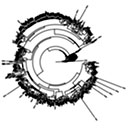 |
 |
|
Pringle Laboratory Genetic Architecture of Symbiosis Symbiosis is commonly associated with gene loss, but ectomycorrhizal fungi appear to have expanded genomes. The genus Amanita encompasses both asymbiotic and ectomycorrhizal species, and we are currently working with the genomes of six of these species to identify the genetic hallmarks of symbiosis. Wang, Y.-W., J. Hess, J.C. Slot, A. Pringle. 2020. De novo gene birth, horizontal gene transfer and gene duplication as sources of new gene families associated with the origin of a symbiosis in the fungal genus Amanita. Genome Biology and Evolution 12:2168-2182. Hess J., I. Skrede, M. Chaib de Mares, M. Hainault, B. Henrissat, A. Pringle. 2018. Rapid divergence of genome architectures following the origin of an ectomycorrhizal symbiosis in the genus Amanita. Molecular Biology and Evolution 35:2786-2804. Chaib de Mares M., J. Hess, D. Floudas, A. Lipzen, C. Choi, M. Kennedy, I.V. Grigoriev, A. Pringle. 2014. Horizontal transfer of carbohydrate metabolism genes into ectomycorrhizal Amanita. New Phytologist 205:1552-1564. Hess J., I. Skrede, B.E. Wolfe, K. LaButti, R. Ohm, I. Grigoriev, A. Pringle. 2014. Transposable element dynamics among asymbiotic and ectomycorrhizal Amanita fungi. Genome Biology and Evolution 6:1564-1578. Wolfe B.E., R.E. Tulloss, A. Pringle. 2012. The irreversible loss of a decomposition pathway marks the single origin of an ectomycorrhizal symbiosis. PLoS ONE 7(7):e39597. [download] |
 A phylogeny of one group of transposable elements in Amanita. |